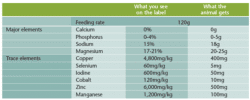Out The Gap – Issue 11


Feeding The Dry Cow
Inadequate mineral supplementation during the dry period can cause problems with new born calf health, as well as a greater risk of problems with cow health.
Cow health problems from inadequate mineral supplementation include:
- Clinical and subclinical milk fever
- Ketosis
- Retained cleanings
- Low dry matter intake
- Displaced abomasum
- Fertility problems
Pre-calving minerals should be fed to dry cows for six weeks pre calving.
Milk fever is a common problem on dairy farms. Typically if your herd is showing 5% clinical milk fever, then roughly 33% of your herd are suffering from sub clinical milk fever. Sub clinical milk fever is a gateway disorder, with such cows being more susceptible to retained cleanings, metritis, ketosis, lower production, and poor fertility performance. When assessing your herd, risks of getting milk fever are:
- Herd body condition score, with fat cows being 4 times more likely to suffer from milk fever
- Herd age, with cows on their third and greater lactation being more likely to suffer
- Calcium status
- History – cows with previous milk fever cases are 10 times more likely to have it again.
Why does milk fever happen at calving?
A dry cows calcium requirement is 33-55% of her milking requirement. Grass silage generally supplies an excess of calcium for a dry cow but a deficit of calcium for a milking cow. During the dry period the cow stores this excess. Once she starts to bag up, her diet cannot meet her requirements and she needs to drag calcium from her bones. This switch to drawing calcium requires a hormonal change, which is controlled by the cows magnesium, phosphorus, and vitamin D nutrition. With the onset of lactation, and production of colostrum, the cows requirement for calcium increases substantially (400% increase in a day). To meet these calcium requirements, the cow must increase both the absorption and resorption processes. Any factors that interfere with these processes mean the cow cannot meet the increased demand for calcium, and this results in lowered blood calcium concentration and milk fever.
There are many factors that influence milk fever, including nutritional and management factors, as well as other outside of the farmers control, such as the weather.
There is also the potassium effect. An excess of potassium limits magnesium absorption, delaying the release of calcium and increasing the incidence of milk fever. Grass silage with greater that 1.5% potassium can cause issues. Grazed grass can contain 2-2.5 times the level of potassium as grass silage leading to higher levels of milk fever from cows calved off grazed grass.
Magnesium is the key mineral for the prevention of sub clinical milk fever. The cow requires 20-25g /cow/ day (17% -21% Mg in the mix for a 120g feeding rate). Trace minerals and vitamins (copper, selenium, zinc etc.) should be fed from at least six weeks pre calving to achieve adequate levels for the calving period. Ensure enough vitamin D (>120,000 unit per kg) is included in the mineral supplement to help milk fever.

Mind those cows!

